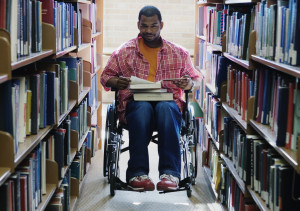Ever since Ben Franklin started a “subscription library” back in 1731, in which members paid for shares in order to borrow books, Americans have had a love affair with libraries. Andrew Carnegie believed so strongly in libraries that he donated the money to build 2,509 of them, 1,689 of which were built in the United States. More recently, former First Lady Laura Bush was quoted as saying that the most valuable thing in her wallet is her library card.
“With a library you are free, not confined by temporary political climates. It is the most democratic of institutions because no one—but no one at all—can tell you what to read and when and how.” – Doris Lessing
BUT, if you have a disability and your library is not ADA compliant, you are not free to enjoy this cornerstone of democracy, and we, as a society, have a problem.
A BARRIER-FREE LIBRARY
When a lot of people think about access, they think about getting into a building. But ADA compliance goes deeper that that, with the goal of making it so that a person with a disability is able to use the building for its intended purpose.
For the library, this includes such things as*:
Lighting
Library lighting must be strong enough, without glare and consistent throughout the library. When possible, lighting should shine across stacks rather than run parallel. A review of ADA compliant lighting is not equivalent to a review of lighting codes, but a determination of whether or not lighting is adequate so that someone with visual impairment can use the collection.
Circulation Desks
New circulation desks must include a lower section (no higher than 36″) so that children and disabled patrons can access it. If a circulation desk that is higher than 36″ is in place, and can’t be retrofitted, a small table should be placed nearby.
Stacks
Aisles between stack areas should be at least 36 inches wide. Perimeter aisles around the stacks should be at least 40 inches wide, and no furniture or stools should block the aisles. Stack signs should be printed in high contrast (black against white, for example) and be at least 3 inches high.
These are just a few examples of things that must be addressed to make sure a library is accessible.
*For more information on requirements for library lighting, circulation desks and stacks, as well as other library-related issues, this ADA Compliance List from the Kansas State Library is a useful resource.
RESOLVING ISSUES
What should you do when you encounter a barrier to accessibility at a public library?
Ask to speak to the library director
Express your concerns and find out if any efforts are currently being made to bring the building into compliance. If so, no more needs to be done at the moment.
Contact Access Advocates
If no plans to remedy the situation are in the works, contact us at Access Advocates. Our staff will walk you through the process of bringing the library into ADA compliance.
Access Advocates works with persons with all types of disabilities, dealing with all kinds of public sector building compliance issues. We will partner with you to remove barriers so that you and all Americans can enjoy everything that the library has to offer.

